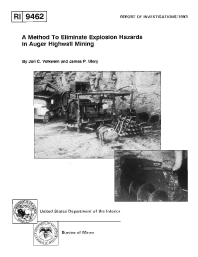 |
The U.S. Bureau of Mines investigated a method of using inert gas to prevent the formation of explosive gas mixtures in auger highwall mining of coal. A combination of gasoline and diesel engine exhaust gases was introduced into the auger drill hole using a short section of pipe located at the collar. Gas samples were taken and analyzed on-site with infrared detectors for oxygen, carbon dioxide, methane, and carbon monoxide. Evacuated bottle samples were also taken and analyzed by gas chromatography in the laboratory. These gas results were analyzed for explosibility. Coal samples from various depths were used to obtain the gas content of the coal using the modified direct method. Personal exposure to carbon monoxide was also monitored. The highest methane level observed was 9.55%. The levels of inert gas (carbon dioxide and nitrogen) were sufficiently high to prevent any ignition of the methane. Results showed that for all conditions during mining, gas concentrations were nonexplosive. The gas content of the coal was about 0.30 cm3/g. The maximum personal time-weighted average sample for carbon monoxide was 20 ppm. This system provides a safe, inexpensive, simple method for preventing explosions during auger mining.
| Author(s): | Volkwein-JC, Ulery-JP |
| Reference: | U.S. Department of the Interior, Bureau of Mines, Report of Investigations 9462, NTIS No. PB93-190411, 1993:1-14 |
ri9462 (PDF, 3723 KB)